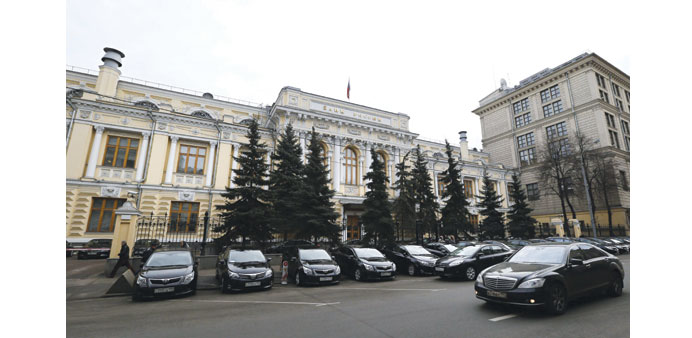An exterior view of the Russian central bank building in Moscow. The Bank of Russia left its benchmark interest rate unchanged for a third consecutive meeting as a slump in oil prices triggered a new bout of rouble weakness, raising the risk of faster inflation.
Bloomberg
Moscow
Russia’s central bank left its benchmark interest rate unchanged for a third consecutive meeting as a slump in oil prices triggered a new bout of rouble weakness, raising the risk of faster inflation.
Policy makers held the one-week auction rate at 11%, the Bank of Russia said in a statement yesterday. Twenty-two of 36 economists predicted the move, with the rest forecasting a reduction of 50 basis points, according to a Bloomberg survey. The central bank said it will restart easing if price growth slows in line with its forecasts and inflation risks recede.
The collapse in oil prices is the latest shock to sidetrack the central bank from chasing its 4% medium-term inflation target. The world’s largest energy exporter has careened from one crisis to the next since President Vladimir Putin annexed Crimea from Ukraine in March 2014. With consumer prices growing almost four times as quickly as the goal, policy makers also had to weigh the effects of trade measures against Turkey and a new highway toll. The central bank governor Elvira Nabiullina last month left open the possibility of holding borrowing costs until March after five rate cuts brought the benchmark to 11% in July.
“While the Bank of Russia confirmed that the next step is likely to be a cut, the weaker rouble and the restrictions imposed on Turkish food are likely prevent inflation from decelerating as fast as previously anticipated and may delay the resumption of the easing cycle until after the first quarter,” Piotr Matys, a strategist for emerging-market currencies at Rabobank in London, said by e-mail. “The main message embedded in the official statement is still fairly dovish.”
The rouble maintained losses after the decision and traded 1.1% weaker at 69.93 against the dollar in Moscow. It’s lost more than 8% against the dollar since the last rate meeting on Oct 30, the third-worst performance among 24 emerging-market currencies tracked by Bloomberg. Brent crude, used to price Russia’s main export blend, dropped to a six-year low in London this week after Opec last week effectively abandoned output limits.
“It is too soon for the central bank to re-initiate rate cuts,” Daniel Hewitt, an economist at Barclays Plc in London, said before the decision. “The central bank should wait until annual inflation drops and the run rate of inflation slows considerably.”
Inflation slowed for a third month in November to 15% from a year earlier. A decision to ban Turkish food products, including tomatoes, onions, cucumbers and tangerines, may add as much as half a percentage point to inflation, Prime Minister Dmitry Medvedev said Wednesday, citing analyst estimates.
While the ban comes into effect January 1, prices have already grown 0.2% in the seven days through December 7, the biggest weekly increase since early November, according to the Federal Statistics Service.
The rate decision was made “in recognition of growing inflation risks, while the risks of economic cooling remain,” the central bank said in the statement.
Russian policy makers met as the Federal Open Market Committee is poised to raise US interest rates for the first time since 2006 at its December 15-16 meeting. Nabiullina has mentioned possible tightening in the US as one of the biggest threats to Russia’s inflation outlook.
Inflation expectations aren’t anchored, posing a serious issue for monetary policy that’s even a bigger challenge than price growth itself, Bank of Russia First Deputy Governor Ksenia Yudaeva said November 27. That hinders the central bank’s ability to aid an economy battling its first recession in six years. Gross domestic product will contract 3.7% this year, according to Economy Minister Alexei Ulyukayev.
The central bank estimates the economy will shrink 0.5% to 1% in 2016 before growing as much as 1% the following year. Annual inflation will be at about 6% in late 2016 and is on track to reach the 4% target in 2017, according to its statement.
The major sources of inflation risks include further external deterioration against the background of low oil prices, policy normalization by key central banks and a continued slowdown in Chinese economic growth, it said. “Persistently high” inflation expectations, looser fiscal policy and an upward revision in state-regulated tariffs can hamper a decline in price growth, according to the central bank.
“They made the right decision,” said Ivan Tchakarov, a Moscow-based economist at Citigroup Inc “Given that back in October they argued they didn’t cut because of elevated inflation expectations, it would have been very illogical to cut now that inflation risks actually seem larger with the rouble- dollar rate and the Turkish ban.”

